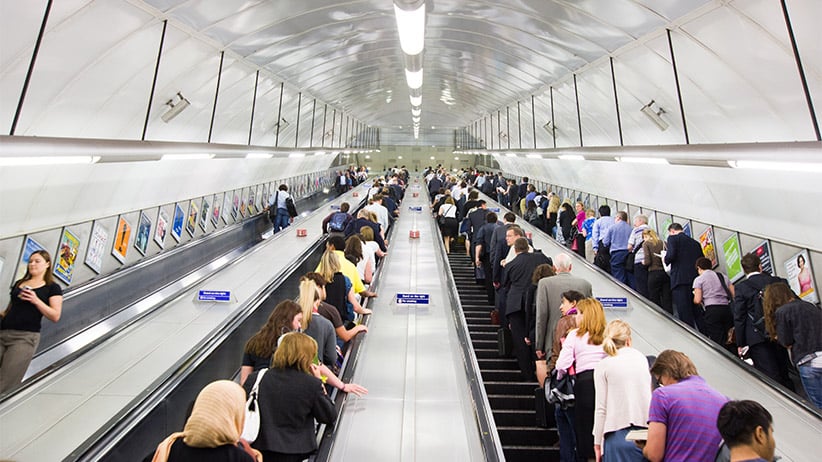imerk
Active Member
Oh wow, new staircases. Wasn't expecting those. They are much needed.
I’m in the Eaton centre a lot and I try to always take the stairs since people on the escalators are so slow and it’s good exercise too so the added staircases are definitely appreciated.Oh wow, new staircases. Wasn't expecting those. They are much needed.
I’m in the Eaton centre a lot and I try to always take the stairs since people on the escalators are so slow
I’ll take this opportunity to point out that escalators are designed for people to stand on both sides equally. By a huge margin, the main reason for escalators being out of service is caused by people standing primarily on the right so that others can pass on the left. The weight imbalance literally causes damage that compounds with time until they break.I’m in the Eaton centre a lot and I try to always take the stairs since people on the escalators are so slow and it’s good exercise too so the added staircases are definitely appreciated.


Yeah, people treat it like a little ride, not a method to move people through a space more quickly.That escalator in particular has always been bad. So glad they put in a staircase.
Thanks for this, never thought of it like that. I always got annoyed when people stand on the left. Although walkers 'take up more space', they are moving faster, so the volume being moved should still be similar or better no? A solution to balance the sides would be switch the "up" and "down" escalators periodically, so the walkers and standers would be switched as well.I’ll take this opportunity to point out that escalators are designed for people to stand on both sides equally. By a huge margin, the main reason for escalators being out of service is caused by people standing primarily on the right so that others can pass on the left. The weight imbalance literally causes damage that compounds with time until they break.

Why the escalator etiquette of 'stand right, walk left' is wrong - Macleans.ca
Whether riding escalators or merging traffic, people feel they know what's fair, and it's messing with the work of transit operators and traffic plannersmacleans.ca

BART says people walking on the left are causing escalators to break faster
Those of us trying to get a little exercise or get to our destination quicker are...www.sfgate.com
When they're forced out of service, they make life worse for everyone.
There are also issues of overall inefficiency in having “slow/fast” lanes on an escalator. "Walkers" take up more space than those standing, and mean fewer overall people on an escalator, creating bigger bottlenecks.
But most of all, it disregards those who have mobility and balance issues or those with small children and creates dangerous situations for all. Falls account for ¾ of all escalator-related injuries, and are the primary reason that the TTC took down its Walk-Left/Stand-Right stickers over 15 years ago:
Yes, the Eaton Centre needs better traffic flow and more stairs.
If you get on an escalator, treat it like a brief respite from walking, like waiting for an elevator or a walk sign at a crosswalk. Except unlike those two examples, you actually get somewhere by the time you get to move. Over walking, it's only a few seconds difference in most cases.
London did a study and showed that there was no efficiency in walking up. Walk left causes congestion at the entry of the escalator.Thanks for this, never thought of it like that. I always got annoyed when people stand on the left. Although walkers 'take up more space', they are moving faster, so the volume being moved should still be similar or better no?

London did a study and showed that there was no efficiency in walking up. Walk left causes congestion at the entry of the escalator.

The tube at a standstill: why TfL stopped people walking up the escalators
It’s British lore: on escalators, you stand on the right. So why did TfL ask people to stop walking on the left? And could it help solve a looming congestion crisis?www.theguardian.com
…but in stations with long, steep walkways, only a small proportion are likely to be willing to climb. In lots of places, with short escalators or minimal congestion, this doesn’t much matter. But a 2002 study of escalator capacity on the Underground found that on machines such as those at Holborn, with a vertical height of 24 metres, only 40% would even contemplate it. By encouraging their preference, TfL effectively halves the capacity of the escalator in question, and creates significantly more crowding below, slowing everyone down.
That may be, but the bottlenecking at the bottom will still be the same. You're still constraining the input by nearly half in order to leave room for people to pass. And even then, any perceived efficiency in walking means absolutely no one can stand on the left.From the article
I don’t think it’s saying walking up has no efficiency but only if people choose not to walk up while also leaving room on the left for few who choose to walk up. And the test was done on pretty long escalators whereas a lot of Eaton Centres’ (and TTC’s) are much shorter.
Also this is really only about overall efficiency, the fast walkers will still always be ahead.

Okay, but if you miss one, another will be along in a minute. If your plans can come crashing down due to a difference in seconds, the problem lies with your time management and not people on an escalator.I know countless times I’ve caught a train that the standers couldn’t cause I walked.
I cannot imagine the type of damage that comes from striking the edge of a steel, slatted stair edge. Geez.Definitely. I used to rent an office at the Eaton Centre, in the section that is accessible using the escalator in front of Mercatto. And one day I was in a hurry, ran up with my coffee, tripped and, well... skin was shredded and blood flowed.
If a driver is driving in the left lane at the posted speed limit and another vehicle approaches from behind, does the driver need to move out of the left lane?
Yes. The rule requires the driver to move out of the left lane even if the driver is driving at the posted speed limit.
My lesson to myself is to not text while going up/down stairs. Lesson learnt.Maybe the solution is for people on both sides to walk?
The stairs do, however, provide a good option - both up and down - they would be faster than just standing still on an escalator.... although I doubt you can eliminate the tripping hazard on stairs due to the need to move your feet.